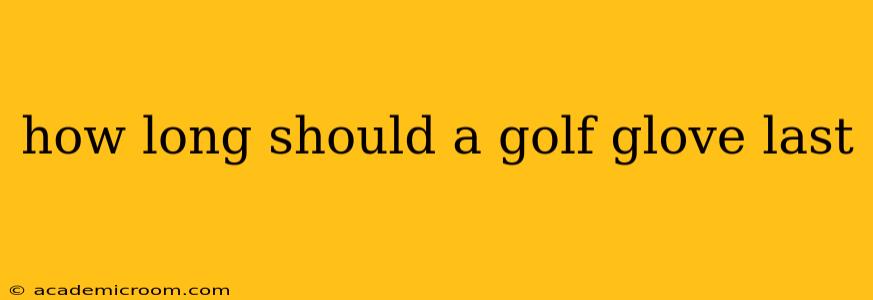Choosing the right golf glove is crucial for a comfortable and confident game. But how long should that perfect glove actually last? The lifespan of a golf glove isn't a fixed number of rounds; it depends on several factors. This guide will explore those factors, helping you understand when it's time to replace your trusty glove and maximize your investment.
How Many Rounds Should a Golf Glove Last?
There's no magic number of rounds a golf glove should last. Some golfers might get 30 rounds out of a glove, while others might need a new one after just 10. The longevity depends heavily on several key factors, which we'll examine in detail below. Instead of focusing on rounds, it's better to focus on the condition of the glove. Is it still providing a good grip? Is it still comfortable? Is it starting to tear or degrade? These are the real indicators.
What Factors Affect Golf Glove Lifespan?
Several factors contribute to how long your golf glove will last. Understanding these will help you better manage your glove usage and extend its lifespan.
1. Material:
- Leather: High-quality leather gloves generally last longer than synthetic options. Full-grain leather is particularly durable, offering superior grip and longevity. However, they require more care and conditioning.
- Synthetic: Synthetic gloves are more affordable and often more water-resistant, but they tend to wear out faster than leather gloves. They might be a better choice for golfers playing frequently in wet conditions, even though they need replacing more often.
2. Frequency of Use:
The more you play, the faster your glove will wear out. Playing multiple rounds a week will significantly shorten its lifespan compared to playing once a month.
3. Weather Conditions:
Harsh weather conditions like excessive heat, cold, and rain will dramatically affect your glove's lifespan. Prolonged exposure to sunlight can dry out leather, making it brittle and prone to cracking. Constant rain will soak the glove, leading to premature wear and tear.
4. Hand Sweat:
Excessive hand sweat can degrade the glove's material faster. Using a moisture-wicking glove liner can help to mitigate this.
5. Proper Care and Maintenance:
Proper care significantly extends a golf glove's lifespan. Regular cleaning and conditioning (especially for leather gloves) can help maintain its flexibility and prevent premature wear.
When Should I Replace My Golf Glove?
It's time for a new golf glove when:
- The Grip is Compromised: If the glove is no longer providing a secure grip on the club, it's time for a replacement. This is crucial for consistent shots and preventing injuries.
- Significant Wear and Tear: Look for holes, cracks, or significant wear on the palm and fingers. These signs indicate the glove is losing its structural integrity.
- Loss of Comfort: A worn-out glove can be uncomfortable, leading to distractions during your game. If your glove feels stiff, uncomfortable, or generally worn down, it's a sign that it should be replaced.
- It's Dirty and Beyond Cleaning: While regular cleaning is recommended, if your glove has accumulated excessive dirt and grime that's difficult to remove, it's likely time for a new one.
How Can I Extend the Life of My Golf Glove?
Here are some tips to keep your glove in top condition for longer:
- Air it Out: After each round, allow your glove to air out completely to prevent the buildup of moisture and bacteria.
- Clean Regularly: Use a soft brush and mild detergent to remove dirt and grime. For leather gloves, consider using a specialized leather cleaner and conditioner.
- Store Properly: Store your glove in a cool, dry place away from direct sunlight. Avoid storing it in a damp or airtight container.
- Use a Glove Liner: Consider a moisture-wicking liner to help absorb sweat and extend the life of your glove.
By understanding these factors and following these tips, you can significantly extend the life of your golf glove and ensure you always have a comfortable and reliable grip on the club. Remember, a well-maintained glove is an investment in your game.
